The West Coast is home to various edible and interesting mushrooms. Washington’s warm humid winters and mild summers host a lot of interesting mushrooms! The following list includes our top 10 mushrooms found in the state of Washington.
King Bolete (Boletus sp.)
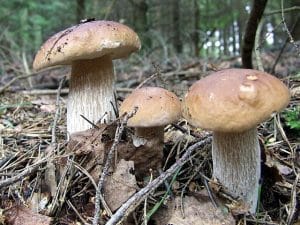
King Bolete mushrooms are also known as Penny Bun or Porcini mushrooms. This mushroom grows in deciduous and coniferous forests, yet is not the easiest mushroom to find, given that it is beloved and quickly eaten by wildlife. They produce spores on a pore surface and not on gills. They can be found growing during the summer and autumn seasons. The body is comprised of a brown cap, averaging 12 inches in diameter, with an off-white stalk that reaches an average of eight inches tall. The King Bolete is difficult to cultivate because it is symbiotic with local tree species. It is one of the most sought-after wild edible mushrooms due to its texture and flavor.
Shaggy Mane (Coprinus comatus)
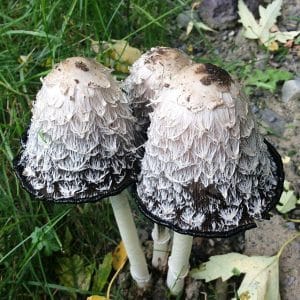
Shaggy Mane mushrooms are another easily identifiable mushroom. This mushroom is also known as the Lawyer’s Wig mushroom, It is a type of Inky Cap mushroom. This mushroom has three lookalikes, including the common Ink Cap, Snowy Ink Cap, and Wooly Ink Cap mushrooms, and is also closely related to other inky cap mushroom varieties. The Shaggy Mane mushroom commonly grows on lawns and is a primarily white mushroom that resembles the powdered, white wigs that were once commonly associated with lawyers and judges. It is important to know that when foraging these mushrooms, they dissolve into a black residue even while fresh, and will gradually dissolve more with age. The gills are known for producing an ink-like residue, hence the name Inky Cap mushroom.
Western Chicken of the Woods (Laetiporus conifericola/gilbertsonii)
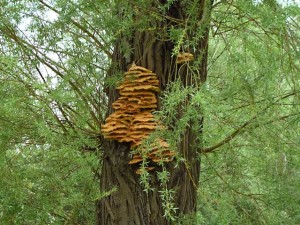
Western Chicken of the Woods is a particularly easy-to-spot mushroom in the wild, as this mushroom has a vibrant orange color. Chicken of the woods is a polypore which means that spores are released from a porous surface underneath the cap, and no gills are present. Chicken of the Woods is also known as Sulphur Shelf, as it resembles a shelf-like structure. However, Chicken of the Woods was named based on its texture and flavor, which has been described to resemble chicken meat. This mushroom often reaches two to 10 inches in width and can weigh over 100 pounds. Laetiporus gilbertsonii is most commonly found on decaying or dead oak and eucalyptus trees. Laetiporus conifericola is most commonly found on decaying or dead conifers such as Hemlock and douglas fir. They are best harvested from spring to autumn.
Hedgehog Mushroom (Hydnum repandum)
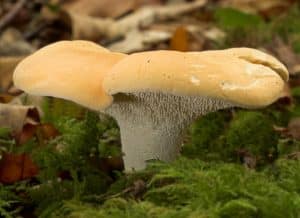
The Hedgehog mushroom is also known as the Spreading Hedgehog mushroom or the Sweet Tooth mushroom. It is one of the easiest and safest mushrooms to identify and eat in the state. They are commonly known as Sweet Tooth due to the “teeth” underneath the cap, rather than having gills like other mushrooms. Hedgehog mushrooms grow from the ground, most often closer to trees in mixed forests. However, make sure to plan ahead to find this type of mushroom, as they only grow during December on the west coast.
Western Cauliflower (Sparassis crispa)
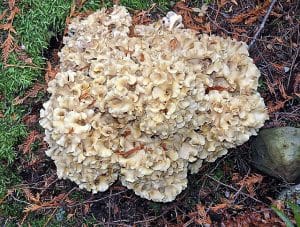
Also known as the Noodle Mushroom, Cauliflower of the Woods, Silver Ear, and Snow Ear, this mushroom is an interesting-looking fungus that shares a similar appearance to cauliflower, with a twisty and curly off-white cap. While this mushroom is mostly of European origin, and somewhat uncommon, a few varieties grow in Washington. Western Cauliflower is parasitic, as it grows on dead or decaying trees. You’ll often find this variety growing in clumps between four and 10 inches wide and generally during the summer months.
Meadow Mushroom (Agaricus campestris)
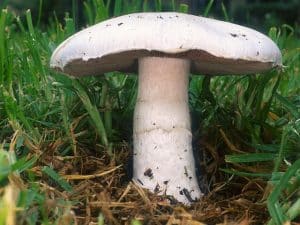
The Meadow Mushroom is one of the more difficult mushrooms to identify on this list, look-a-likes can range from edible to deadly. They look similar to the commercial button mushrooms commonly found in grocery stores with a white cap and white stem. However, meadow mushrooms often have pink gills underneath that turn brown with age. The younger mushrooms with this mauve-pink color are the best for eating. Two toxic lookalikes to avoid are the somewhat toxic Yellow Stainer and the very deadly deadly Destroying Angel mushroom, both of which share the same cap color, stem color, and shape as a meadow mushroom.
Honey Mushroom (Armillaria ostoyae)
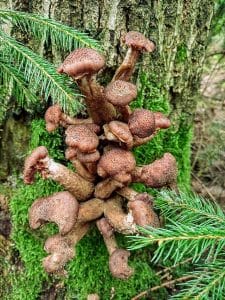
The Armillaria ostoyae mushroom is known for its parasitic properties on the trees it grows on, including hardwood and conifer trees, which means that it quickly kills the host tree. This mushroom spreads through the ground in the form of fungal mycelium(loose fungal strands) and rhizomorphs(dense fungal strands, leaving most of the biomass of the fungi not visible. As the fungi spreads underground it forms a connected network of stands. This mushroom is known for its ability to create a massive connected fungal network, the largest organism in the work is considered to be a network of honey mushroom hyphae(mycelium and rhizomorphs) in Oregon. The armillaria species produce mushrooms from late summer through autumn.
West Coast Reishi (Ganoderma oregonense)
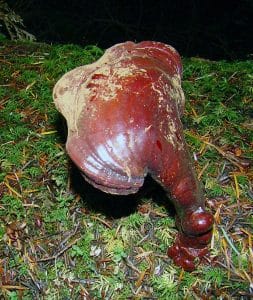
The West Coast Reishi mushroom, also known as the Oregon mushroom, is found throughout Washington, and other western states, including Oregon and California, and is commonly tracked down for its medicinal properties. The West Coast Reishi mushroom is a large, reddish-brown polypore mushroom with a varnished sheen. This mushroom most often grows during autumn and can be located in coastal rainforests or on the trunks of hardwood trees. The body of this mushroom is often confused with the Fomitopsis pinicola, or red-belted conk, mushroom. Reishi mushrooms are one of the most studied genus of mushrooms for their medicinal potential, particularly in terms of improving immune system function.
Lobster Mushroom (Hypomyces lactifluorum)

The Lobster mushroom is an interesting specimen as it doesn’t grow on decaying trees or along forest floors, but rather on other species of mushrooms. This turns the outer shells of mushrooms into a bold red-orange color, similar to the shell of a lobster. Lobster mushroom often grows on members of milk cap and brittlegill mushrooms. The surface of the mushroom is hard and develops hard pimple-like bumps. This hard surface prevents the host mushroom from producing spores. The size of a Lobster mushroom depends on the host mushroom, but it often grows between six to eight inches tall.
With this list of fascinating mushrooms, both beginners and experienced fungi foragers have starting points for learning more about the edible mushrooms throughout Washington!






